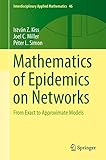Mathematics of Epidemics on Networks [electronic resource] : From Exact to Approximate Models / by István Z. Kiss, Joel C. Miller, Péter L. Simon.
Material type: TextSeries: Interdisciplinary Applied Mathematics ; 46Publisher: Cham : Springer International Publishing : Imprint: Springer, 2017Edition: 1st ed. 2017Description: XVIII, 413 p. 130 illus., 89 illus. in color. online resourceContent type: text Media type: computer Carrier type: online resourceISBN: 9783319508061Subject(s): Biomathematics | Dynamics | Ergodic theory | Physics | Epidemiology | Probabilities | Mathematical and Computational Biology | Dynamical Systems and Ergodic Theory | Applications of Graph Theory and Complex Networks | Epidemiology | Probability Theory and Stochastic ProcessesDDC classification: 570.285 LOC classification: QH323.5QH324.2-324.25Online resources: Click here to access online
TextSeries: Interdisciplinary Applied Mathematics ; 46Publisher: Cham : Springer International Publishing : Imprint: Springer, 2017Edition: 1st ed. 2017Description: XVIII, 413 p. 130 illus., 89 illus. in color. online resourceContent type: text Media type: computer Carrier type: online resourceISBN: 9783319508061Subject(s): Biomathematics | Dynamics | Ergodic theory | Physics | Epidemiology | Probabilities | Mathematical and Computational Biology | Dynamical Systems and Ergodic Theory | Applications of Graph Theory and Complex Networks | Epidemiology | Probability Theory and Stochastic ProcessesDDC classification: 570.285 LOC classification: QH323.5QH324.2-324.25Online resources: Click here to access online | Item type | Current library | Call number | Status | Date due | Barcode | Item holds |
|---|---|---|---|---|---|---|
 e-Books
e-Books
|
Central Library, Sikkim University | 570.285 (Browse shelf(Opens below)) | Not for loan | E-3013 |
Preface -- Introduction to Networks and Diseases -- Exact Propagation Models: Top Down -- Exact Propagation Models: Bottom-Up -- Mean-Field Approximations for Heterogeneous Networks -- Percolation-Based Approaches for Disease Modelling -- Hierarchies of SIR Models -- Dynamic and Adaptive Networks -- Non-Markovian Epidemics -- PDE Limits for Large Networks -- Disease Spread in Networks with Large-scale structure -- Appendix: Stochastic Simulation -- Index.
This textbook provides an exciting new addition to the area of network science featuring a stronger and more methodical link of models to their mathematical origin and explains how these relate to each other with special focus on epidemic spread on networks. The content of the book is at the interface of graph theory, stochastic processes and dynamical systems. The authors set out to make a significant contribution to closing the gap between model development and the supporting mathematics. This is done by: Summarising and presenting the state-of-the-art in modeling epidemics on networks with results and readily usable models signposted throughout the book; Presenting different mathematical approaches to formulate exact and solvable models; Identifying the concrete links between approximate models and their rigorous mathematical representation; Presenting a model hierarchy and clearly highlighting the links between model assumptions and model complexity; Providing a reference source for advanced undergraduate students, as well as doctoral students, postdoctoral researchers and academic experts who are engaged in modeling stochastic processes on networks; Providing software that can solve the differential equation models or directly simulate epidemics in networks. Replete with numerous diagrams, examples, instructive exercises, and online access to simulation algorithms and readily usable code, this book will appeal to a wide spectrum of readers from different backgrounds and academic levels. Appropriate for students with or without a strong background in mathematics, this textbook can form the basis of an advanced undergraduate or graduate course in both mathematics and biology departments alike. .


There are no comments on this title.